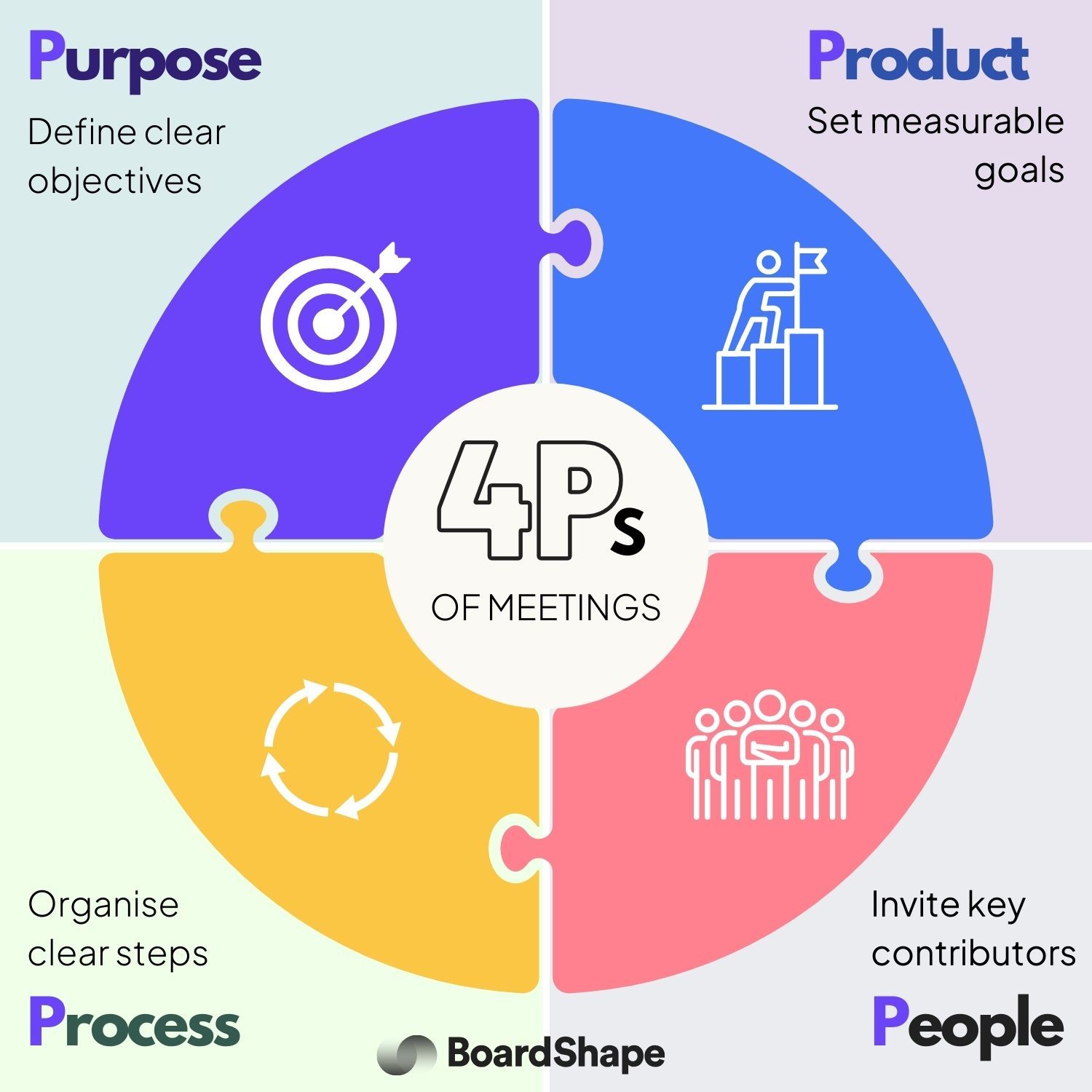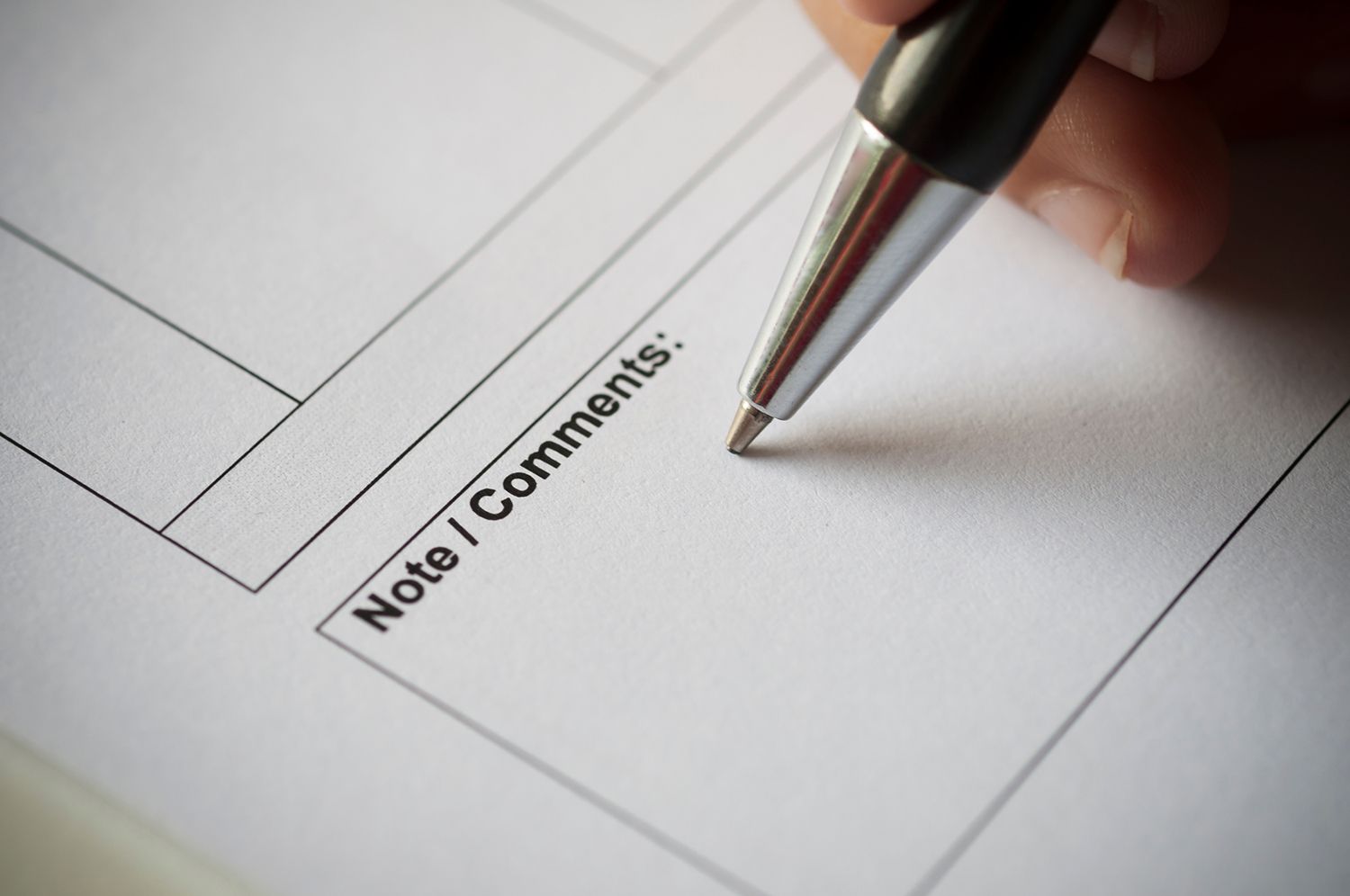Effective committee meetings are essential for successful collaboration, decision-making, and progress.
In this article we explore the keys to success in running successful committee meetings. Download our free checklist to ensure your meetings run seamlessly.
We'll begin with the foundation of an effective meeting; the '4 Ps' – Purpose, Product, People, and Process and then delve into the core elements that underpin successful committee gatherings. From setting the stage with the right committee to thorough preparation and execution, following this guide to will ensure you achieve the progress and collaboration that every committee strives for.
What are the 4 p’s of an effective meeting?

To master the art of running successful committee meetings, let’s start by harnessing the power of the '4 Ps': Purpose, Product, People, and Process. These four essential principles are your guide to orchestrating impactful and streamlined committee gatherings, ensuring your time is well spent and your objectives are met.
1. Purpose
Clearly define the meeting's objective. Keep it concise, ensuring everyone understands their role.
2. Product
Set measurable goals for the meeting. Identify necessary resources to achieve those goals.
3. People
Invite relevant participants who can contribute. Create a respectful and collaborative environment.
4. Process
Establish an agenda and share it in advance. Define roles, set ground rules, and manage time effectively.
Close with a recap and follow up with notes.
Why Do They Matter?
These principles ensure productive and outcome-driven meetings. They save time and shift attitudes toward meetings. Productivity is a top priority for any business.
Key Criteria for Establishing an Effective Committee
In this section, we delve into the crucial factors that underpin an effective committee. From defining clear objectives to fostering open communication and maintaining compliance,
- Clear Purpose and Goals: Define the committee's purpose, objectives, and expected outcomes. Without a clear sense of purpose, a committee may wander aimlessly.
- Relevant Membership: Ensure that committee members have the necessary skills, expertise, and diversity to contribute to the committee's goals. Appoint individuals who can provide valuable insights and actively participate.
- Leadership: Designate a capable chairperson or leader who can guide meetings, manage conflicts, and keep the committee focused on its objectives.
- Defined Roles and Responsibilities: Clearly outline the roles and responsibilities of each committee member, including specific tasks, timelines, and deliverables. This promotes accountability.
- Regular Meetings: Establish a consistent meeting schedule to maintain momentum and progress. Regular communication is vital for sharing updates, discussing issues, and making decisions.
- Agenda and Minutes: Create and distribute meeting agendas in advance. Record detailed meeting minutes to track discussions, decisions, and action items. This ensures everyone stays informed and accountable.
- Effective Communication: Foster open and transparent communication among committee members. Encourage constructive feedback, idea sharing, and active listening.
- Resources and Support: Provide the committee with the necessary resources, such as access to information, budget, or tools, to fulfill its objectives effectively.
- Adherence to Bylaws and Regulations: Ensure that the committee operates within the guidelines of the organization's bylaws and relevant regulations. Compliance is crucial for legitimacy and integrity.
- Evaluation and Feedback: Periodically assess the committee's performance and solicit feedback from members and stakeholders. Use this information to make necessary improvements.
- Flexibility and Adaptability: Be open to adjustments and refinements in the committee's structure and processes based on changing needs, goals, and external factors.
9 steps in preparing for a committee meeting

Effective committee meetings require thorough preparation. From setting clear objectives, and creating detailed agendas to designating roles and managing time. Follow these 9 steps for success.
-
Set Clear Objectives
Clearly define what you aim to achieve during the meeting.
-
Create a detailed Agenda
List topics to be covered, allocate time for each, and clarify the expected outcomes.
-
Gather Relevant Material
Accumulate all necessary documents, reports, and data to inform and guide discussions.
-
Notify Attendees
Send meeting invites, ensuring they include the agenda and any materials for pre-reading.
-
Review Past Minutes
Familiarize yourself with the proceedings of the previous meeting to ensure continuity.
-
Prepare Discussion Points
Frame main points and draft questions for each agenda topic to stimulate meaningful conversation.
-
Designate Roles
Clearly assign roles like the chairperson, timekeeper, or note-taker to facilitate the meeting flow.
-
Time Management
Allocate specific time slots for each agenda item, ensuring the meeting remains on track.
-
Technical Setup
Double-check that all technological tools, from video conferencing software to presentation setups, are functional and ready for use.
By carefully addressing each of these preparation points, you lay the groundwork for a focused, efficient, and productive committee meeting.
How to Run a Successful Committee Meeting
 By adhering to these guidelines, you will conduct productive and efficient committee meetings that achieve their objectives.
By adhering to these guidelines, you will conduct productive and efficient committee meetings that achieve their objectives.
-
Start on Time
Starting promptly not only sets a professional tone but also demonstrates respect for participants' time.
-
Stick to the Agenda
Ensure you follow the pre-set agenda. This will help the meeting stay on course and cover all planned topics.
-
Engage Participants
Foster an environment where all members feel comfortable sharing ideas. Encourage open yet respectful discussions.
-
Decision-Making
After discussions, make sure decisions are well-understood and documented. Clearly assign action items to responsible parties.
-
Manage Conflicts
In the event of disagreements, address them head-on but constructively. Always steer the conversation back to the main agenda.
-
Respect the Schedule
Remember to wrap up the meeting as scheduled. This shows respect for participants' time and other commitments.
By implementing these guidelines, you'll be well on your way to conducting meetings that achieve their objectives and foster a positive collaborative environment.
After the meeting

-
Follow Up
Distribute the meeting minutes and assigned action items promptly. This ensures clarity and keeps everyone aligned on the next steps.
-
Continuous Improvement
Actively seek feedback from participants. Their insights can provide invaluable guidance on how to refine and enhance the quality of future meetings.
-
Reflect and Adapt
Take time to assess the effectiveness of each meeting. Identify areas of strength and those that might need tweaking. Adapt accordingly to ensure each subsequent meeting is better than the last.
FAQ’s
What do you say to start a committee meeting?
You call the meeting to order. If it is a formal meeting you would say; “I call this meeting to order at (time) on (date)” For informal meeting you can vary your speech and could say something like ‘We are beginning this meeting at (time) on (date)
How do you preside a committee meeting?
By downloading our checklist for running a successful committee meetings you will have everything covered.
Discover Boardshape
Our board management tool stands out as an essential resource for enhancing your online meetings. With our agenda creator, you can:
- Jointly craft meeting agendas.
- Delegate agenda items to your team.
- Consolidate all discussion resources.
- Embed live surveys for quick decisions.
- Effortlessly track subsequent discussions using comments for each topic.
Our presentation mode means seamless synchronization during meetings, ensuring everyone has the right documents readily available at the right time.

